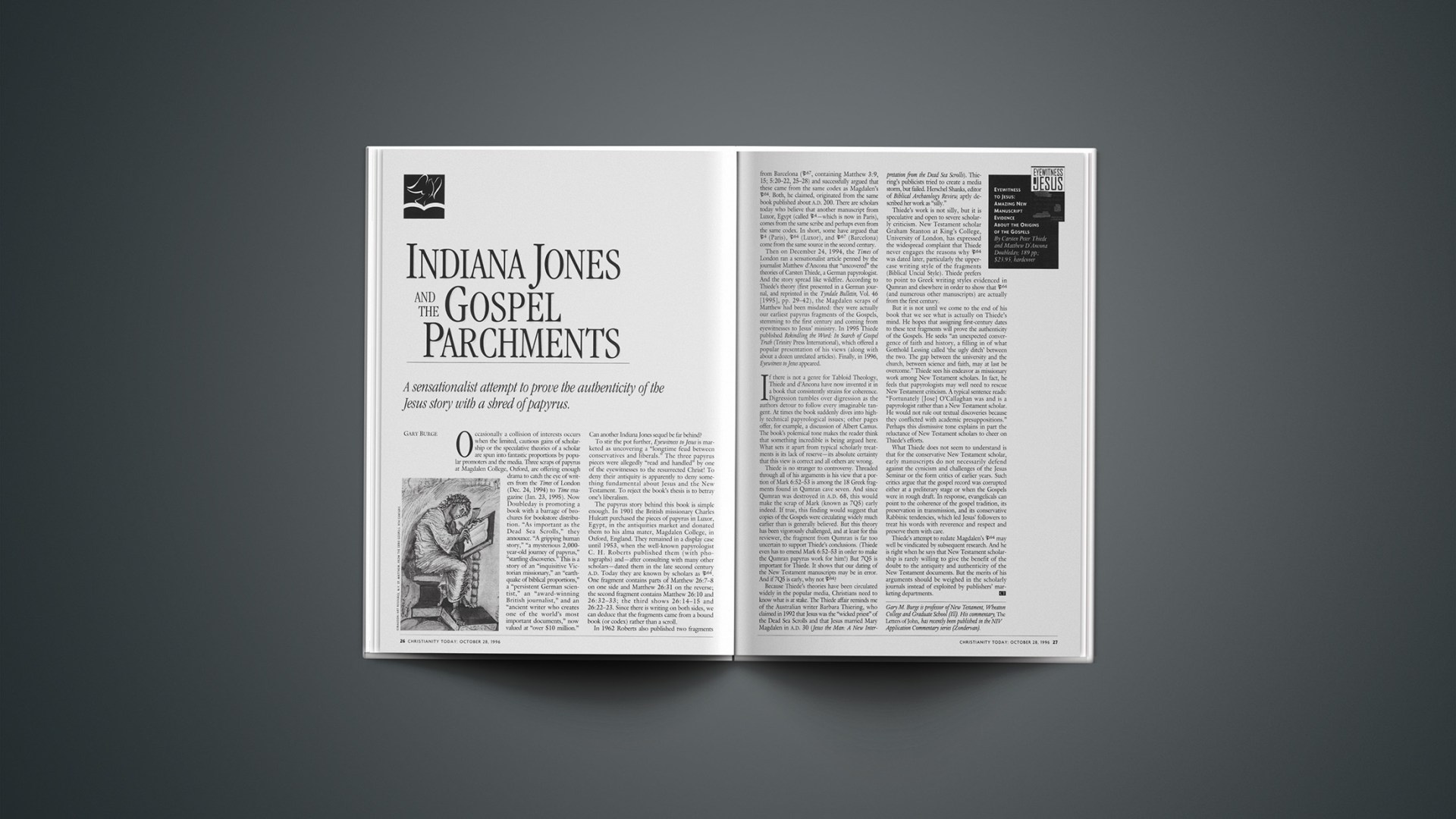Occasionally a collision of interests occurs when the limited, cautious gains of scholarship or the speculative theories of a scholar are spun into fantastic proportions by popular promoters and the media. Three scraps of papyrus at Magdalen College, Oxford, are offering enough drama to catch the eye of writers from the Times of London (Dec. 24, 1994) to Time magazine (Jan. 23, 1995). Now Doubleday is promoting a book with a barrage of brochures for bookstore distribution. “As important as the Dead Sea Scrolls,” they announce. “A gripping human story,” “a mysterious 2,000-year-old journey of papyrus,” “startling discoveries.” This is a story of an “inquisitive Victorian missionary,” an “earthquake of biblical proportions,” a “persistent German scientist,” an “award-winning British journalist,” and an “ancient writer who creates one of the world’s most important documents,” now valued at “over $10 million.” Can another Indiana Jones sequel be far behind?
To stir the pot further, Eyewitness to Jesus is marketed as uncovering a “longtime feud between conservatives and liberals.” The three papyrus pieces were allegedly “read and handled” by one of the eyewitnesses to the resurrected Christ! To deny their antiquity is apparently to deny something fundamental about Jesus and the New Testament. To reject the book’s thesis is to betray one’s liberalism.
The papyrus story behind this book is simple enough. In 1901 the British missionary Charles Huleatt purchased the pieces of papyrus in Luxor, Egypt, in the antiquities market and donated them to his alma mater, Magdalen College, in Oxford, England. They remained in a display case until 1953, when the well-known papyrologist C. H. Roberts published them (with photographs) and—after consulting with many other scholars—dated them in the late second century a.d. Today they are known by scholars as P64. One fragment contains parts of Matthew 26:7-8 on one side and Matthew 26:31 on the reverse; the second fragment contains Matthew 26:10 and 26:32-33; the third shows 26:14-15 and 26:22-23. Since there is writing on both sides, we can deduce that the fragments came from a bound book (or codex) rather than a scroll.
In 1962 Roberts also published two fragments from Barcelona (P67, containing Matthew 3:9, 15; 5:20-22, 25-28) and successfully argued that these came from the same codex as Magdalen’s P64. Both, he claimed, originated from the same book published about a.d. 200. There are scholars today who believe that another manuscript from Luxor, Egypt (called P4—which is now in Paris), comes from the same scribe and perhaps even from the same codex. In short, some have argued that P4 (Paris), P64 (Luxor), and P67 (Barcelona) come from the same source in the second century.
Then on December 24, 1994, the Times of London ran a sensationalist article penned by the journalist Matthew d’Ancona that “uncovered” the theories of Carsten Thiede, a German papyrologist. And the story spread like wildfire. According to Thiede’s theory (first presented in a German journal, and reprinted in the Tyndale Bulletin, Vol. 46 [1995], pp. 29-42), the Magdalen scraps of Matthew had been misdated: they were actually our earliest papyrus fragments of the Gospels, stemming to the first century and coming from eyewitnesses to Jesus’ ministry. In 1995 Thiede published Rekindling the Word: In Search of Gospel Truth (Trinity Press International), which offered a popular presentation of his views (along with about a dozen unrelated articles). Finally, in 1996, Eyewitness to Jesus appeared.
If there is not a genre for Tabloid Theology, Thiede and d’Ancona have now invented it in a book that consistently strains for coherence. Digression tumbles over digression as the authors detour to follow every imaginable tangent. At times the book suddenly dives into highly technical papyrological issues; other pages offer, for example, a discussion of Albert Camus. The book’s polemical tone makes the reader think that something incredible is being argued here. What sets it apart from typical scholarly treatments is its lack of reserve—its absolute certainty that this view is correct and all others are wrong.
Thiede is no stranger to controversy. Threaded through all of his arguments is his view that a portion of Mark 6:52-53 is among the 18 Greek fragments found in Qumran cave seven. And since Qumran was destroyed in a.d. 68, this would make the scrap of Mark (known as 7Q5) early indeed. If true, this finding would suggest that copies of the Gospels were circulating widely much earlier than is generally believed. But this theory has been vigorously challenged, and at least for this reviewer, the fragment from Qumran is far too uncertain to support Thiede’s conclusions. (Thiede even has to emend Mark 6:52-53 in order to make the Qumran papyrus work for him!) But 7Q5 is important for Thiede. It shows that our dating of the New Testament manuscripts may be in error. And if 7Q5 is early, why not P64?
Because Thiede’s theories have been circulated widely in the popular media, Christians need to know what is at stake. The Thiede affair reminds me of the Australian writer Barbara Thiering, who claimed in 1992 that Jesus was the “wicked priest” of the Dead Sea Scrolls and that Jesus married Mary Magdalen in a.d. 30 (Jesus the Man: A New Interpretation from the Dead Sea Scrolls ). Thiering’s publicists tried to create a media storm, but failed. Herschel Shanks, editor of Biblical Archaeology Review, aptly described her work as “silly.”
Thiede’s work is not silly, but it is speculative and open to severe scholarly criticism. New Testament scholar Graham Stanton at King’s College, University of London, has expressed the widespread complaint that Thiede never engages the reasons why P64 was dated later, particularly the upper-case writing style of the fragments (Biblical Uncial Style). Thiede prefers to point to Greek writing styles evidenced in Qumran and elsewhere in order to show that P64 (and numerous other manuscripts) are actually from the first century.
But it is not until we come to the end of his book that we see what is actually on Thiede’s mind. He hopes that assigning first-century dates to these text fragments will prove the authenticity of the Gospels. He seeks “an unexpected convergence of faith and history, a filling in of what Gotthold Lessing called ‘the ugly ditch’ between the two. The gap between the university and the church, between science and faith, may at last be overcome.” Thiede sees his endeavor as missionary work among New Testament scholars. In fact, he feels that papyrologists may well need to rescue New Testament criticism. A typical sentence reads: “Fortunately [Jose] O’Callaghan was and is a papyrologist rather than a New Testament scholar. He would not rule out textual discoveries because they conflicted with academic presuppositions.” Perhaps this dismissive tone explains in part the reluctance of New Testament scholars to cheer on Thiede’s efforts.
What Thiede does not seem to understand is that for the conservative New Testament scholar, early manuscripts do not necessarily defend against the cynicism and challenges of the Jesus Seminar or the form critics of earlier years. Such critics argue that the gospel record was corrupted either at a preliterary stage or when the Gospels were in rough draft. In response, evangelicals can point to the coherence of the gospel tradition, its preservation in transmission, and its conservative Rabbinic tendencies, which led Jesus’ followers to treat his words with reverence and respect and preserve them with care.
Thiede’s attempt to redate Magdalen’s P64 may well be vindicated by subsequent research. And he is right when he says that New Testament scholarship is rarely willing to give the benefit of the doubt to the antiquity and authenticity of the New Testament documents. But the merits of his arguments should be weighed in the scholarly journals instead of exploited by publishers’ marketing departments.
-Gary M. Burge is professor of New Testament, Wheaton College and Graduate School (Ill). His commentary, The Letters of John, has recently been published in the NIV Application Commentary series (Zondervan).
Copyright © 1996 Christianity Today. Click for reprint information.
Last Updated: October 9, 1996










